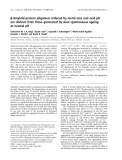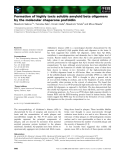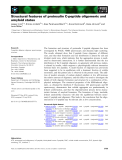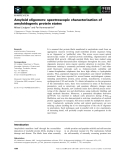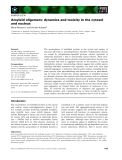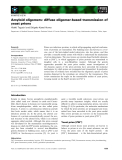
Amyloid oligomers
-
Amyloid protein (Ab1–40) aggregation and conformation was examined using native and sodium dodecyl sulfate/ polyacrylamide gel electrophoresis,and the results com-pared with those obtained by atomic force microscopy, and with Congo red binding,sedimentation and turbidity assays. The amount of Ab aggregation measured was different,depending upon the method used. Incubation for 15 min at pH 5.0 or in the presence of Fe 2+ ,Cu 2+ or Zn 2+ did not alter the level of Aboligomers observed on SDS and native gels....
 12p
12p  tumor12
tumor12
 20-04-2013
20-04-2013
 43
43
 4
4
 Download
Download
-
Protein aggregation is central to most neurodegenerative diseases, as shown by familial case studies and by animal models. A modified ‘amyloid cas-cade’ hypothesis for Alzheimer’s disease states that prefibrillar oligomers, also called amyloid-b-derived diffusible ligands or globular oligomers, are the responsible toxic agent. It has been proposed that these oligomeric spe-cies, as shown for amyloid-b, b2 -microglobulin or prion fragments, exert toxicity by forming pores in membranes, initiating a cascade of detrimental events for the cell. ...
 10p
10p  awards
awards
 06-04-2013
06-04-2013
 42
42
 3
3
 Download
Download
-
Alzheimer’s disease (AD) is a neurological disorder characterized by the presence of amyloidb(Ab) peptide fibrils and oligomers in the brain. It has been suggested that soluble Ab oligomers, rather than Ab fibrils, contribute to neurodegeneration and dementia due to their higher level of toxicity.
 12p
12p  vinaphone15
vinaphone15
 28-02-2013
28-02-2013
 34
34
 2
2
 Download
Download
-
A great deal must still be learnt on the structural features of amyloid assemblies, particularly prefibrillar aggregates, and the relationship of the latter with amyloid cytotoxicity. Presently, it is recognized that the popula-tion of unstable, heterogeneous amyloid oligomers and protofibrils is mainly responsible for amyloid cytotoxicity.
 12p
12p  viettel02
viettel02
 19-02-2013
19-02-2013
 38
38
 4
4
 Download
Download
-
The formation and structure of proinsulin C-peptide oligomers has been investigated by PAGE, NMR spectroscopy and dynamic light scattering. The results obtained show that C-peptide forms oligomers of different sizes, and that their formation and size distribution is altered by salt and divalent metal ions, which indicates that the aggregation process is medi-ated by electrostatic interactions.
 10p
10p  viettel02
viettel02
 19-02-2013
19-02-2013
 42
42
 3
3
 Download
Download
-
It is assumed that protein fibrils manifested in amyloidosis result from an aggregation reaction involving small misfolded protein sequences being in an ‘oligomeric’ or ‘prefibrillar’ state. This review covers recent optical spectroscopic studies of amyloid protein misfolding, oligomerization and amyloid fibril growth.
 9p
9p  mobifone23
mobifone23
 18-01-2013
18-01-2013
 50
50
 3
3
 Download
Download
-
The accumulation of misfolded proteins in the cytosol and nucleus of neuronal cells leads to neurodegenerative disorders. Polyglutamine diseases are caused by polyglutamine-expanded proteins, whereas mutations in superoxide dismutase 1 lead to amyotrophic lateral sclerosis.
 11p
11p  mobifone23
mobifone23
 18-01-2013
18-01-2013
 42
42
 3
3
 Download
Download
-
Prions are infectious proteins, in which self-propagating amyloid conforma-tions of proteins are transmitted. The budding yeast Saccharomyces cerevi-siae, one of the best-studied model eukaryotes, also has prions, and thus provides a tractable model system with which to understand the mechanisms of prion phenomena.
 10p
10p  mobifone23
mobifone23
 18-01-2013
18-01-2013
 33
33
 3
3
 Download
Download
-
Alzheimer’s disease (AD) is an age-related, progressive degenerative dis-order that is characterized by synapse and neuron loss in the brain and the accumulation of protein-containing deposits (referred to as ‘senile plaques’) and neurofibrillary tangles. Insoluble amyloid b-peptide (Ab) fibrillar aggregates found in extracellular plaques have long been thought to cause the neurodegenerative cascades of AD.
 11p
11p  mobifone23
mobifone23
 18-01-2013
18-01-2013
 50
50
 4
4
 Download
Download
CHỦ ĐỀ BẠN MUỐN TÌM









